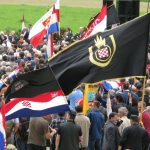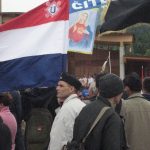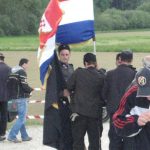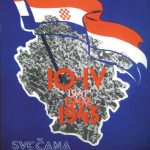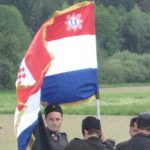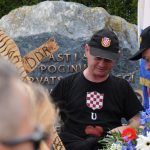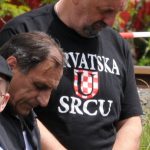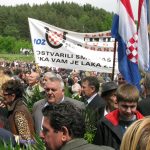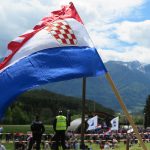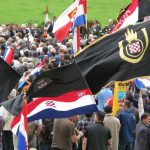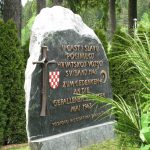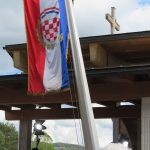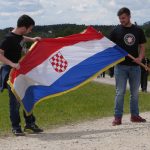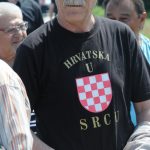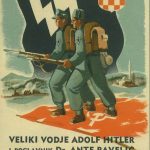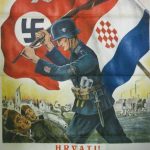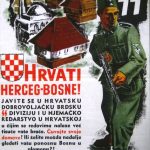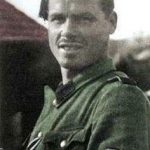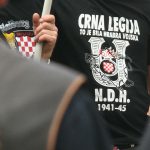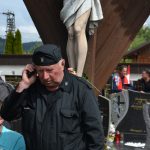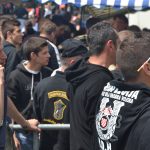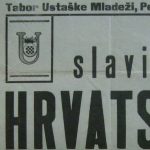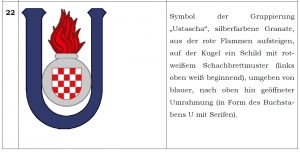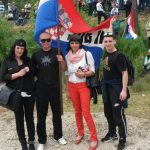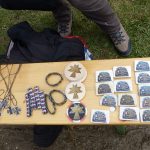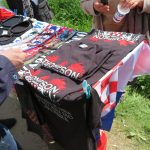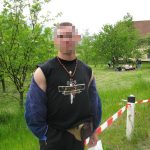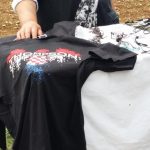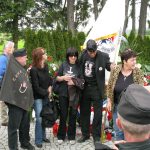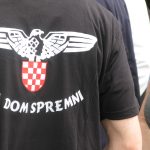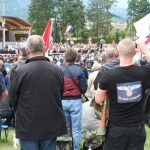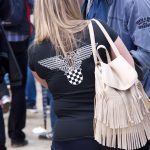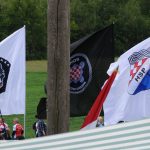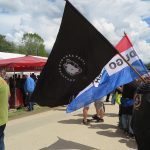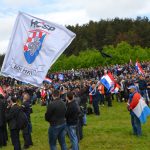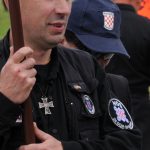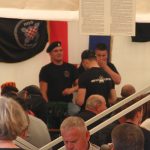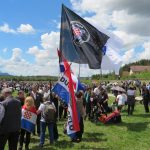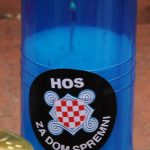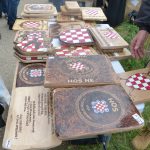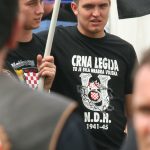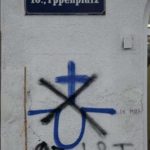For the Ustaša celebration not only place, persons and historical dates are of great importance, but also the symbols shown and used there. These serve the participants to easily identify themselves with the content of the events or rather to create a direct positive reference to the fascist ancestors of the event, through the associated historical references.
Prohibition of symbols
Various Austrian laws regulate the wearing of fascist symbols (Prohibition Act, EGVG, Badge Law, Symbols Act), but are partly rigidly focused on the historical National Socialism of Austria. Other historical fascist movements are not or difficult to grasp with these regulations (Arrow Cross Party, Ustaša, Franquists, etc.). The majority of the symbols shown and sold at the Ustaša celebration in Bleiburg / Pliberk are therefore not prohibited in Austria. While this booklet is being printed, an amendment to the "Symbols Act" is under debate, although it is still unclear how much this will actually prohibit the symbols displayed during the ceremony.
Modernized adoption of fascist symbols
The symbols of the NDH state are rarely used in their historical variants but in modernized versions. For example, in the Croatian War of Independence (1991-1995), soldiers and paramilitaries used variations of Ustaša symbols on flags or uniforms. This complicates the correct recognition for anti-fascists (as well as also press and authorities, by the way).
NDH flag (with Ustaša emblem and Ustaša crest)
These examples show the flag of the NDH state (1941-1945) without any change, a tricolor of red, white, and blue with the Ustaša symbol in top-left corner (letter "U" surrounded by Croatian interlace) and the Croatian coat of arms (with the first field white) in the center. Exhibition is highly problematic with regard to the crimes committed under this flag and in the name of the NDH state. From a legal point of view (VerbG, EGVG, AbzG) there is no sanction against this flag. Whether the Symbols Act (see above) sanctions it is still unknown at the time of printing.
Ustaša emblem ("U")
The central identification symbol for the Ustaša is the "U". It was historically used mostly in combination with the Ustaša coat of arms, but sometimes also appears alone - both historically and in Bleiburg / Pliberk. The "U" appears in Bleiburg / Pliberk in various combinations and new designs. Displaying this symbol (on flags / T-shirts / etc.) is highly problematic with regards to the crimes committed in the name of the Ustaša. From a legal point of view (VerbG, EGVG, AbzG) nothing can be done against the U. Whether the Symbols Act (see above) sanctions it is still unknown at the time of printing.
Ustaša coat of arms (chessboard)
The Ustaša coat of arms consists of a chessboard pattern (Croatian: Šahovnica / chessboard) with a 5x5 field, which begins with a white field. It is to be strictly distinguished from today's coat of arms of the Republic of Croatia (chessboard, starting with red field). The Ustaša coat of arms is the central symbol of the Ustaša and the NDH state. It already appeared in the fascist propaganda before 1941 and attained its elevation to the state coat of arms in the NDH state. As such, it is featured on propaganda posters, the uniforms of the Croatian Home Guard (Domobrani), Ustaša, Croatian Wehrmacht members, the Croatian SS unit (13th Waffen-SS-Division, 'Handschar'), airplanes of the Croatian Air Force, etc. The Ustaša coat of arms is also an important part of many other symbols, such as the paramilitary Croatian Defence Forces (HOS), the “Bleiburger Ehrenzug”, etc. The Ustaša coat of arms was worn by the 13th Waffen-SS-Division 'Handschar' as sleeve insignia. Thus it falls under the prohibition standard of the Austrian Badge Law. It may not be shown or sold in Austria, exhibition of it is punishable by a fine of up to 4,000 Euros and results in the seizure of the symbol / object, although the Carinthian authorities refuse to do so with reference to the coat of arms already being used before 1941. At the time of printing, it is unclear whether the Symbols Act will sanction the coat of arms.
Ustaša-U (with grenade)
This symbol of a large "U" and an ignited grenade inside it is an early Ustaša symbol, but in particular it was a military badge. Thus it is to be found on the Ustaša cap as a badge (Kokade) or on the collar. Its most terrible association probably comes from this Ustaša symbol being part of the entrance sign to the Jasenovac concentration camp. Showing this symbol (on flags / t-shirts / etc.) is extremely problematic due to the crimes associated with it, but from a legal point of view (VerbG, EGVG, AbzG) there is no way to deal with it; only the Symbols Act will sanction this symbol.
Symbols of the Croatian Home Guard (Domobrani)
Historical symbols of the Croatian Home Guard (“Hrvatsko Domobranstvo”, black cross on a white background, so-called 'Croatian Trefoil') are shown less frequently in Bleiburg / Pliberk than Ustaša symbols. Numerous visitors wear a small Domobran pin on the lapel. Supporters of the Domobrani are also present with flags and symbols at the celebration, although the symbols represent new formations and are not historical symbols. However, the historical reference is clear and problematic. The example shows a banner with the inscription "Hrvatski Domobran - za Hrvatsku uvijek" (“Croatian Home Guard - always for Croatia”) and the years 1868-1941-1991. This builds a very shaky historical continuity: 1868 refers to the establishment of the Croatian-speaking “Landwehr” (territorial forces) after the Compromise between Austria and Hungary, 1941 refers to the founding of the fascist NDH state and 1991 to the newly established army of the Republic of Croatia. Showing the “Croatian Trefoil” (on flags / t-shirts / etc.) is highly problematic with regard to the crimes committed on behalf of this union. From a legal point of view (VerbG, EGVG, AbzG, Symbols Act) it is not punishable.
Thompson symbols and T-shirts
Thompson is both the nickname of Marko Perković and the name of his band. Perković is a neo-Nazi musician who glorifies Ustaša fascism and the NDH state in his songs. He participated in the Croatia war as a paramilitary, which contributes to his popularity in Croatia and among exile-Croatians. Thompson's performances include, among others, the fascist Ustaša song "Jasenovac i Gradiška Stara", in which the murder of Jews and Serbs in the Jasenovac concentration camp and one of its subcamps is applauded. Various T-shirts of the band can often be seen during the Ustaša celebration in Bleiburg / Pliberk, in some years they can also be acquired. There are no legal means against Thompson garments, also not according to the Symbols Act.
Imperial eagle with Ustaša coat of arms
Probably to emphasize the ideological / political intention behind the Ustaša coat of arms, it is sometimes combined on T-shirts with the imperial eagle of the Nazi state. The imperial eagle carries the Ustaša coat of arms - instead of the swastika - in its claws. The resulting symbol thus represents a clear reference both to the fascist NDH state and to National Socialist Germany. As a "replacement symbol" for a Nazi symbol, it falls under the Badge Law, wearing and selling this symbol is prohibited in Austria and carries a one-time administrative penalty of up to €4,000.
Party flags
Numerous Croatian right-wing parties are also represented in Bleiburg / Pliberk (flags, T-shirts, jackets, wreaths, etc.), their symbols / flags are not prohibited. These parties and their logos are:
- HSP (Hrvatska stranka prava, Croatian Party of Rights), logo: crest with diagonal beams, wolf; the party is openly fascist and right-wing extremist; it was not until 2017 that it had made an election poster in the style of the National Socialist "Winterhilfswerk" (Winter Relief of the German People).
- HSP-AS (Hrvatska stranka prava Dr. Ante Starčević), logo: crest with diagonal beam; the right-wing extremist party split from the HSP in 2009; Starčević is the originator of a Greater Croatia ideology.
- HSP-1861 (Hrvatska stranka prava 1861), logo: coat of arms with diagonal beam; the right-wing extremist party split from the HSP in 1995, the 1861 refers to the original founding date of the HSP.
- HČSP (Hrvatska čista stranka prava, HDY), logo: coat of arms with Croatian interlace knot in the middle; the right-wing extremist party was founded in 1992 as a spin-off from the HSP.
HOS Emblem
The HOS (Hrvatske obrambene snage, "Croatian Defence Forces") was a paramilitary unit (Croats, Bosniaks, German/Austrian neo-Nazis) during the Croatia War (1991-1995). The HOS took numerous borrowings from the NDH state and the Ustaša movement. For example, the HOS logo carries the Ustaša coat of arms centrally on top of a blue knot pattern similar to the NDH coat of arms, including the NDH greeting "Za dom spremni". The abbreviation "HOS" (for Hrvatske obrambene snage) is a deliberate reference to the name of the army of the fascist NDH state (Hrvatske oružane snage / HOS, "Croatian Armed Forces"). The HOS logo, on flags and T-shirts, is to be seen everywhere in Bleiburg / Pliberk but it is not forbidden; whether it will be included in the Symbols Act is not foreseeable at the time of printing.
Crna legija
The "Crna Legija" (Black Legion) was both a sub-unit of the Ustaša Army and a sub-unit of the HOS (see above), which in turn referred to the former. Both committed numerous war crimes and atrocities during World War II and during the Croatian War. References to Crna legija are created during the Bleiburg ceremony by flags and T-shirts, numerously worn and sold.
Ustaša-U with cross
What can often be seen as sprayed graffiti in (large) cities, such as in Vienna, can hardly be found in Bleiburg / Pliberk: the Ustaša-U with a cross above it. In the context of graffiti, its primary purpose is to take up space, usually in competition with other nationalist symbols. One reason why it is barely seen in Bleiburg / Pliberk: The authorities have no objection to the original fascist symbols being shown, so there is no reason to bother with the "replacement symbol".
References
Donnerbauer/ Glanzl (2017): Hitlergrüße und Hakenkreuze: Das war das Nazi-Gedenken der katholischen Kirche in Bleiburg, in: vice.com, May 15th, 2017.
Kurier (2018): Landeshauptmann Kaiser gegen kroatische Gedenkfeier in Kärnten: https://kurier.at/politik/inland/landeshauptmann-kaiser-gegen-kroatische-gedenkfeier-in-kaernten/400024783, accessed on 28.10.2018.
Öllinger, Karl (2017): Sachverhaltsdarstellung an die Staatsanwaltschaft Klagenfurt. Betr.: Zahlreiche Verstöße gegen das Verbotsgesetzt durch Unbekannte am 13. Mai 2017 in Bleiburg/ Pliberk. Download: http://www.no-ustasa.at/wp-content/uploads/2018/04/Oellinger-Karl_Sachverhaltsdarstellung-Bleiburg-2017.pdf, accessed on 28.10.2018.
Stellungnahme von Diözese Gurk-Klagenfurt, LPD Kärnten und BH Völkermarkt (2018). Download: http://www.no-ustasa.at/presse/, accessed on 28.10.2018.
Verordnung der Stadtgemeinde Bleiburg (2015): Zahl: 120-2-1/Kro-1/2015, Betreff: Gedenkveranstaltung am 16.5.2015 – Loibacher Feld, Verkehrsmaßnahmen. Download: http://www.no-ustasa.at/wp-content/uploads/2018/04/VO-Gendenkfeier-16.05.2015.pdf, accessed on 28.10.2018.
